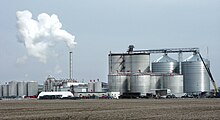Starch as a renewable raw material

Starch , especially potato starch , corn starch and wheat starch , is one of the most important renewable raw materials alongside wood and sugar due to its diverse applications in the chemical-technical industry . The main areas of application for starch are in the production of paper and corrugated cardboard as paper starch and in the fermentation industry as a fermentable substrate for the production of various platform chemicals and bioethanol as a biofuel .
Structure and properties
→ Main article: Strength
As a polysaccharide, starch is a natural biopolymer that is stored in the cells of plants in the form of starch grains as an energy storage substance. It consists of α-D- glucose units ( monomers ) that are linked to one another via glycosidic bonds. This results in the chemical formula (C 6 H 10 O 5 ) n , where C stands for the carbon contained , H for hydrogen and O for oxygen . A starch molecule normally consists of 10 4 to 10 6 glucose units, of which there are two different types:
- 20–30% of the starch consists of amylose , linear chains with a helical (screw) structure that are only linked α-1,4-glycosidically
- 70–80% consists of amylopectin , highly branched structures, with α-1,6-glycosidic and α-1,4-glycosidic linkages.
Due to the OH groups and the glycosidic bond of the individual monomers, starch can be chemically modified in different ways and thus made usable for different purposes. Thus, through various substitutions, starch ethers (starch-OR) or starch esters (starch-O-CO-R) can be obtained, and different molecules can be linked to the starch polymer (RO-starch-OR and / or R-OC-O-starch- O-CO-R). Oxidized starches and starch molecules with increased COOH or CHO groups can be obtained by oxidation of the primary OH groups ; oxidation of the secondary OH groups results in increased CHO and CO groups and ring formation of the molecules C 2 and C 3 . During thermolysis and pyrolysis , laevoglucosan can be obtained with the separation of water , which can be used as a raw material for a number of products.
The glycosidic bonds can be broken by hydrolysis with the help of enzymes or acids , whereby various modified starches , dextrins and starch-based sugars are formed. The latter mainly include glucose (dextrose), maltodextrin , glucose syrup , maltose , fructose and sorbitol .
Origin and composition
| Raw material plant | Starch content (in% of the plant parts used) |
|---|---|
| pea | 40 |
| barley | 75 |
| potato | 82 |
| Corn | 71 |
| manioc | 77 |
| rice | 89 |
| rye | 72 |
| Sorghum | 74 |
| sweet potato | 72 |
| Triticale | 74 |
| wheat | 74 |
Starch for technical applications is obtained from various crops . The most important international starch-producing plants are potatoes , maize and wheat ; nationally, starch plants such as manioc ( tapioca , also cassava), rice and sweet potatoes can play a greater role. These plants represent the bulk of world production of around 45 million tons. There are also other types of grain ( barley , rye , triticale ), peas , sago palms ( sago ) and yams , which are mainly used as starch suppliers for food and feed. In 2007, 1.53 million tons of starch were produced in Germany from potatoes, wheat and maize.
The proportions of the starch types amylose and amylopectin vary depending on the type and variety of the starch plant. Since amylopectin is primarily required for industrial use, starch plants with the highest possible amylopectin content are preferred. In the EU, the genetically modified starch potato variety Amflora is currently in the approval process, the starch of which consists almost exclusively of amylopectins. Other types of barley, the starch of which consists of 95% amylopectin, are based on conventional breeding methods.
The different types and varieties differ not only in their starch content, but also in the composition of the starch and the content of other ingredients such as proteins , lipids and minerals, as well as the moisture content of the untreated starch. These ingredients usually make up about one percent, the moisture is between 10 and 20% of the starch mass. The required moisture content and ingredients are set out in national and international standards.
use
The main part of starch and its products is used in the food industry in the production of confectionery, baked goods, dairy products and especially beverages in the form of starch-based sugars (especially glucose syrup , dextrose and isoglucose ). According to the German Association of Starch Industry eV, this share was 56% of the 1.82 million tons available in Germany in 2008. Due to the properties of starch as a modifiable polymer and its composition of fermentable sugar units, however, starch is also renewable Raw material widely used in the chemical-technical industry; According to the association, the consumption of starch and starch derivatives in the non-food sector in 2008 in Germany was more than 800,000 t. 10% or 182,000 t were used in the chemical and fermentation industries, 35% or 637,000 t were used in paper and corrugated cardboard production.
Strength in the paper industry
The largest technical consumer of starch in Germany is currently the paper industry, which, with 35% of the total starch usage, has a demand of around 637,000 t per year.
Starch is used in paper production as paper starch for treating the paper surface, known as sizing or impregnation . Due to the polymerisation of the gluten it contains, it seals the surface and thus improves the properties of the paper so that it can be written on or printed on with aqueous or alcoholic inks. The effect is based on the water repellency of the paper, which is hydrophilic in its normal state . In the unsized state, water-based and low-viscosity writing materials such as ink or Indian ink would run, and the capillarity of the paper would hinder a clean typeface, as is the case with unsized products such as toilet paper or kitchen paper . Similar effects can also be achieved by using modified cellulose (for example carboxymethyl cellulose ) or polyvinyl alcohol .
In the manufacture of corrugated cardboard , starch is primarily used as starch paste to glue the layers of paper together. For this alone, more than 100,000 t of starch in the form of starch glue were used in Germany in 2008.
Starch as a fermentation substrate

As a glucose polymer, starch represents a natural energy store for plants, which can be broken down in the metabolism of almost all organisms. In the fermentation industry and biotechnology , starch is the most important substrate alongside sucrose for the production of various products that are produced by bacteria or fungi . The spectrum ranges from bioethanol through various amino acids , organic acids such as citric acid and acetic acid , enzymes and antibiotics to biomonomers and polymers such as polyhydroxyalkanoates (PHA; e.g. polyhydroxybutyric acid , PHB) or polylactic acid (PLA). While bioethanol in Brazil is mainly made from sugar from the cultivation of sugar cane , corn is the main raw material in the USA. According to the German bioethanol industry, almost two thirds of bioethanol in Germany is obtained from starchy plants, especially wheat .
The production is usually independent of the substrate, so in almost all fermentation processes both starch and sucrose as well as various sugary products (usually syrup and molasses ) can be used. Since cellulose, as the main component of wood, is a sugar polymer, it stands for future applications, v. a. the production of cellulosic ethanol and its use in biorefineries , also as an alternative substrate for discussion.
Starch-based plastics
→ Main articles: bio-based plastic , starch polymer
Starch plays a role in the manufacture of bio-based plastics . The most important bioplastics based on starch are extruded thermoplastic starches (TPS) and starch blends as well as polylactic acid (PLA). All other bioplastics such as polyhydroxyalkanoates (PHA) together make up less than 5%.
Plastics that are traditionally produced using petrochemicals and for which there are now methods of production on a biogenic basis are also becoming important internationally . These include above all polyethylene (PE), polyethylene terephthalate (PET), polypropylene (PP) and, in the future, probably also polyvinyl chloride (PVC) and polymethyl methacrylate (PMMA).
While thermoplastic starch, starch blends and starch-filled polyolefins represent a direct use of starch or modified starches, PHAs and PLA are produced through fermentation . The fermentation substrate can - as shown above - build on different raw materials. At the moment, maize starch is mainly used for the production of PLA ( NatureWorks in the USA).
Other uses of starch
In addition to the main uses for starch shown, there are a number of other uses, especially in the chemical industry, in the manufacture of cosmetic products and adhesives ( starch paste ) and in the textile industry in the form of laundry starch . For these applications, starch is only used in comparatively small amounts compared to the uses described above.
In the pharmaceutical industry, starch is used in the manufacture of tablets , where it can serve as a filler , disintegrant, binder and powder base .
It also serves, among others, for pickling of cotton , for staining with aniline dyes , for sizing paper , and to thicken colors in the textile printing . In offset printing , a starch powder-air mixture, often made from corn, is applied to the freshly printed surface using powder machines . The powder acts as a spacer between the stacked sheets of paper and promotes the oxidative drying of the printing ink because of the enclosed air .
swell
- ↑ Starch, Chemical Properties. In: Hans Zoebelein (Ed.): Dictionary of Renewable Resources. 2nd Edition. Wiley-VCH, Weinheim / New York 1996, ISBN 3-527-30114-3 , pp. 266-267.
- ↑ Starch and Starch, Composition. In: Hans Zoebelein (Ed.): Dictionary of Renewable Resources. 2nd Edition. Wiley-VCH, Weinheim / New York 1996, ISBN 3-527-30114-3 , pp. 265-266, 267.
- ↑ a b c d e Figures and data on the German starch industry. Information from the Association of Starch Industry eV
- ↑ GM starch potatoes as a renewable raw material: Amflora - a potato for industry. from: bioSicherheit.de Retrieved April 8, 2009.
- ↑ Information on bioethanol production and consumption in 2009 ( memento of the original dated November 26, 2010 in the Internet Archive ) Info: The archive link was inserted automatically and has not yet been checked. Please check the original and archive link according to the instructions and then remove this notice. on the website of the Federal Association of the German Bioethanol Industry. Retrieved September 9, 2009.
literature
- Hans Zoebelein (Ed.): Dictionary of Renewable Resources. 2nd Edition. Wiley-VCH, Weinheim / New York 1996, ISBN 3-527-30114-3 , pp. 265-266, 267.
Web links
- Website of the European Starch Industry Association PDF document
- Facts and figures on the starch industry - edition 2009 (PDF; 211 kB)




